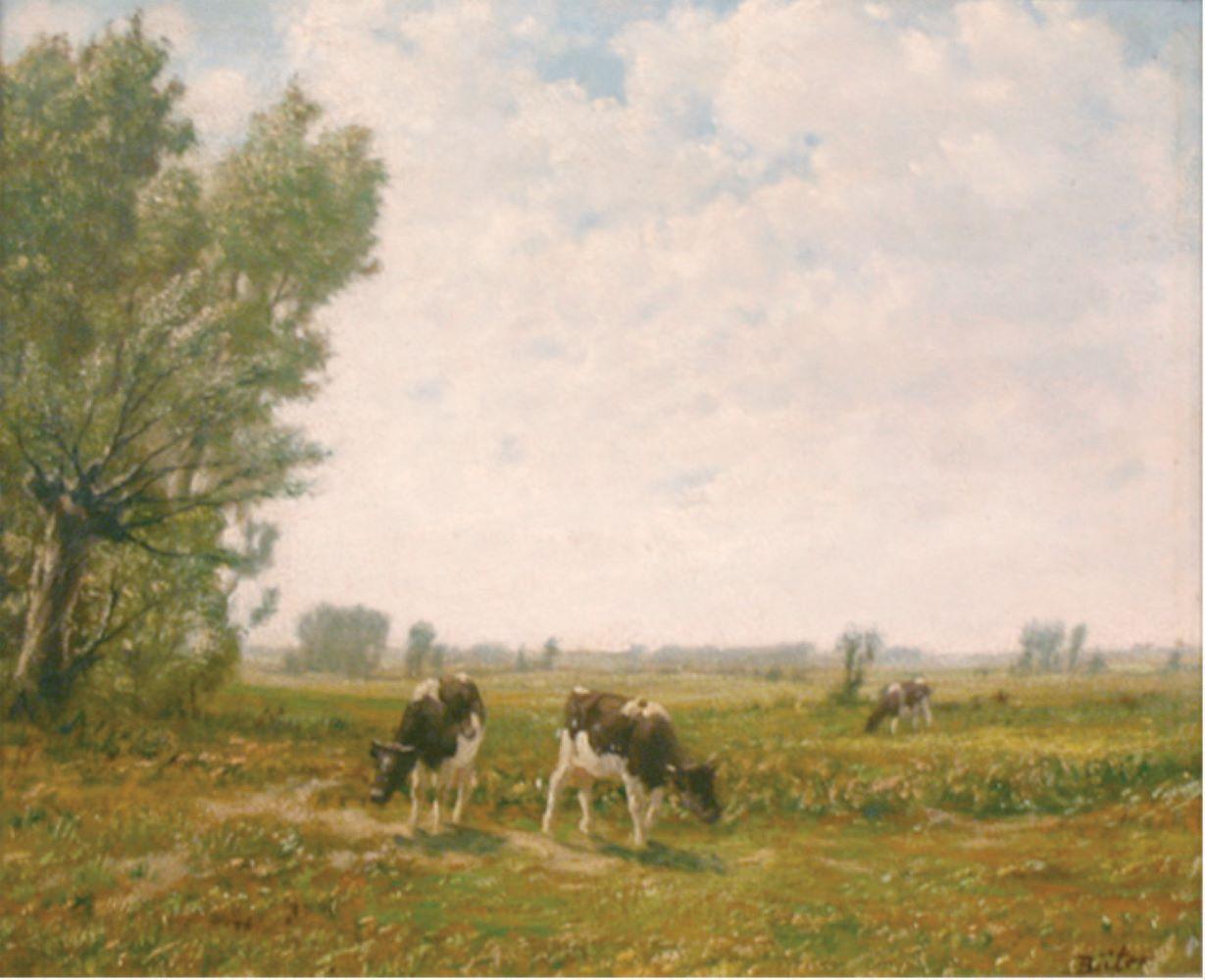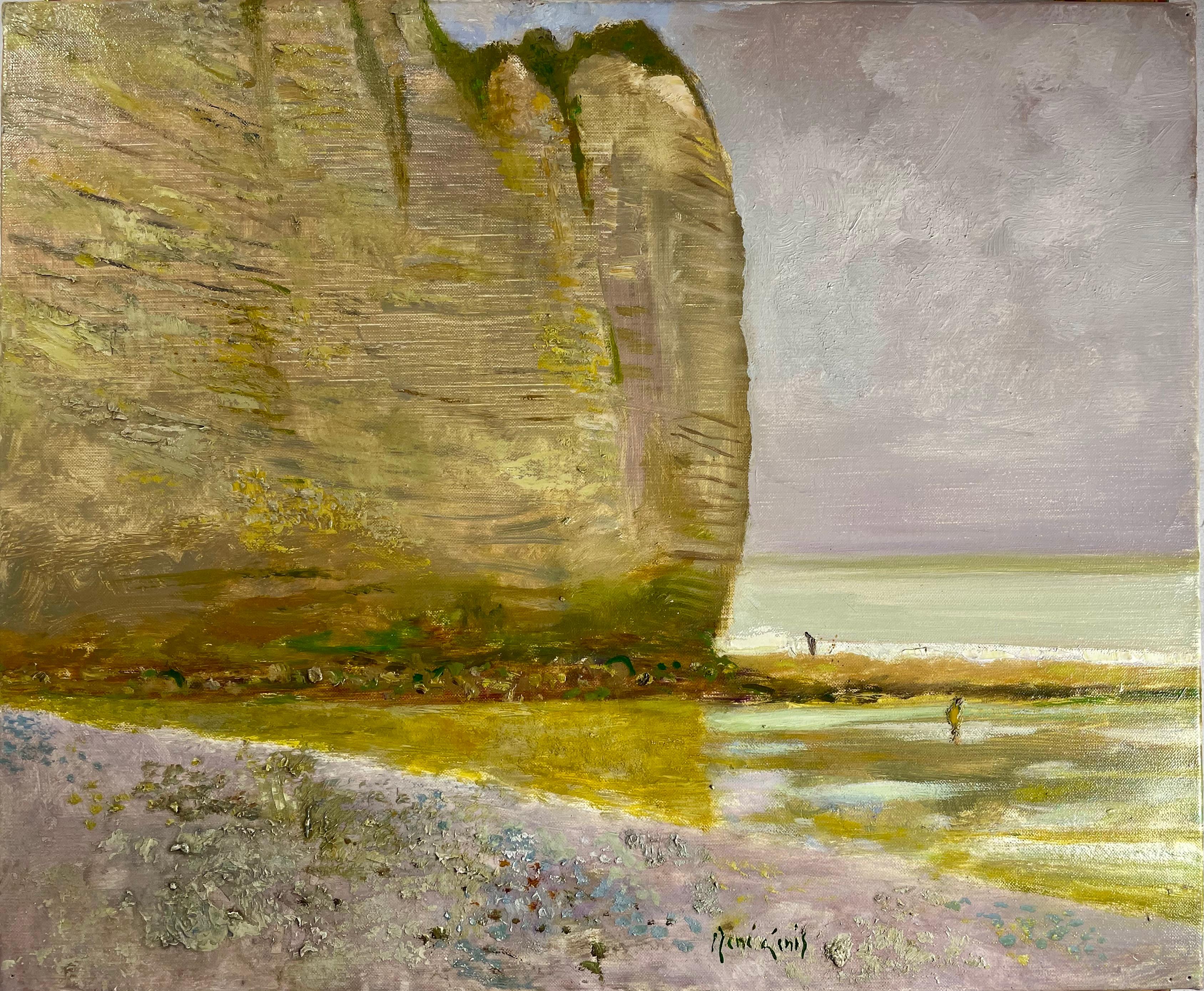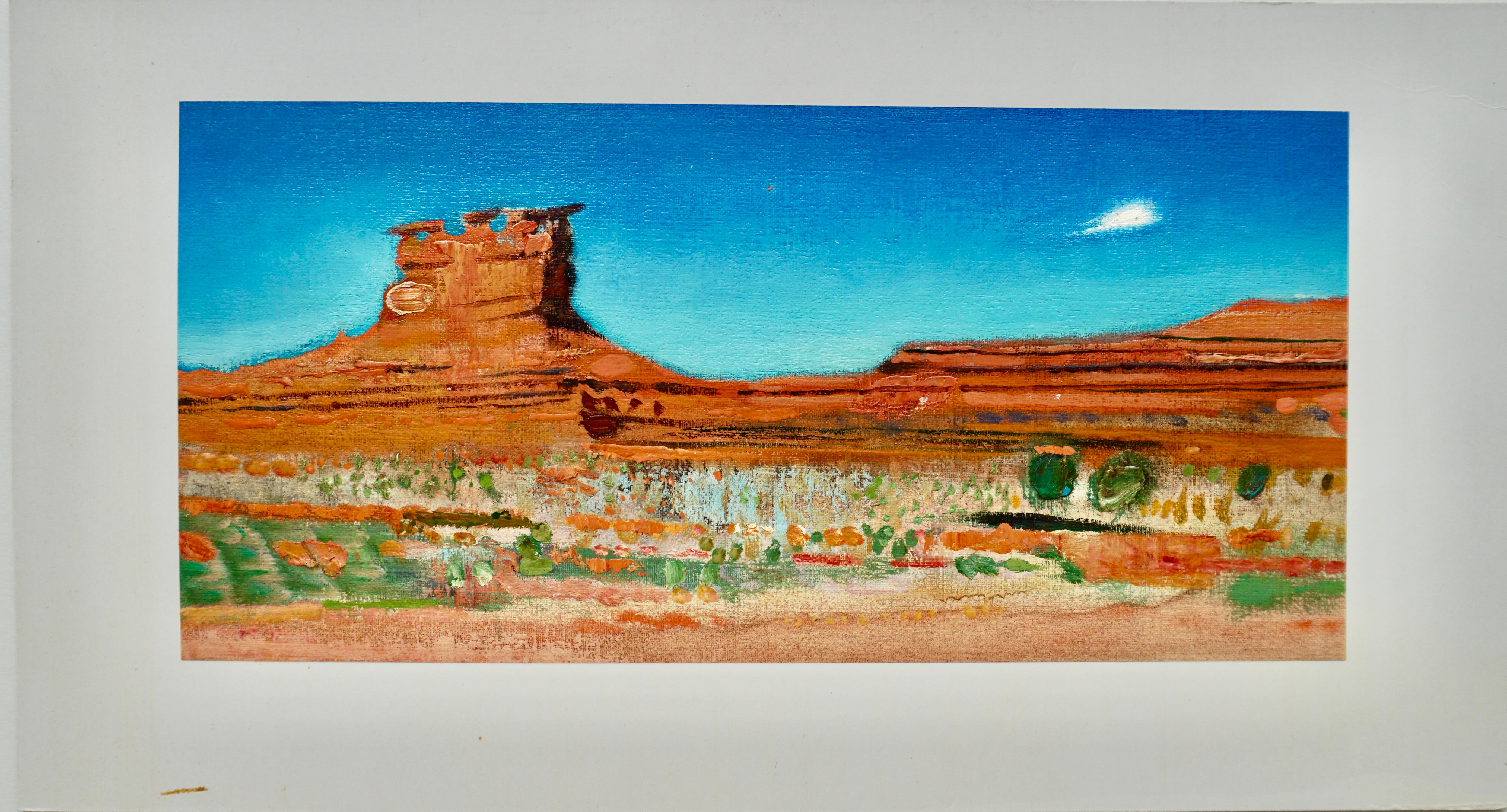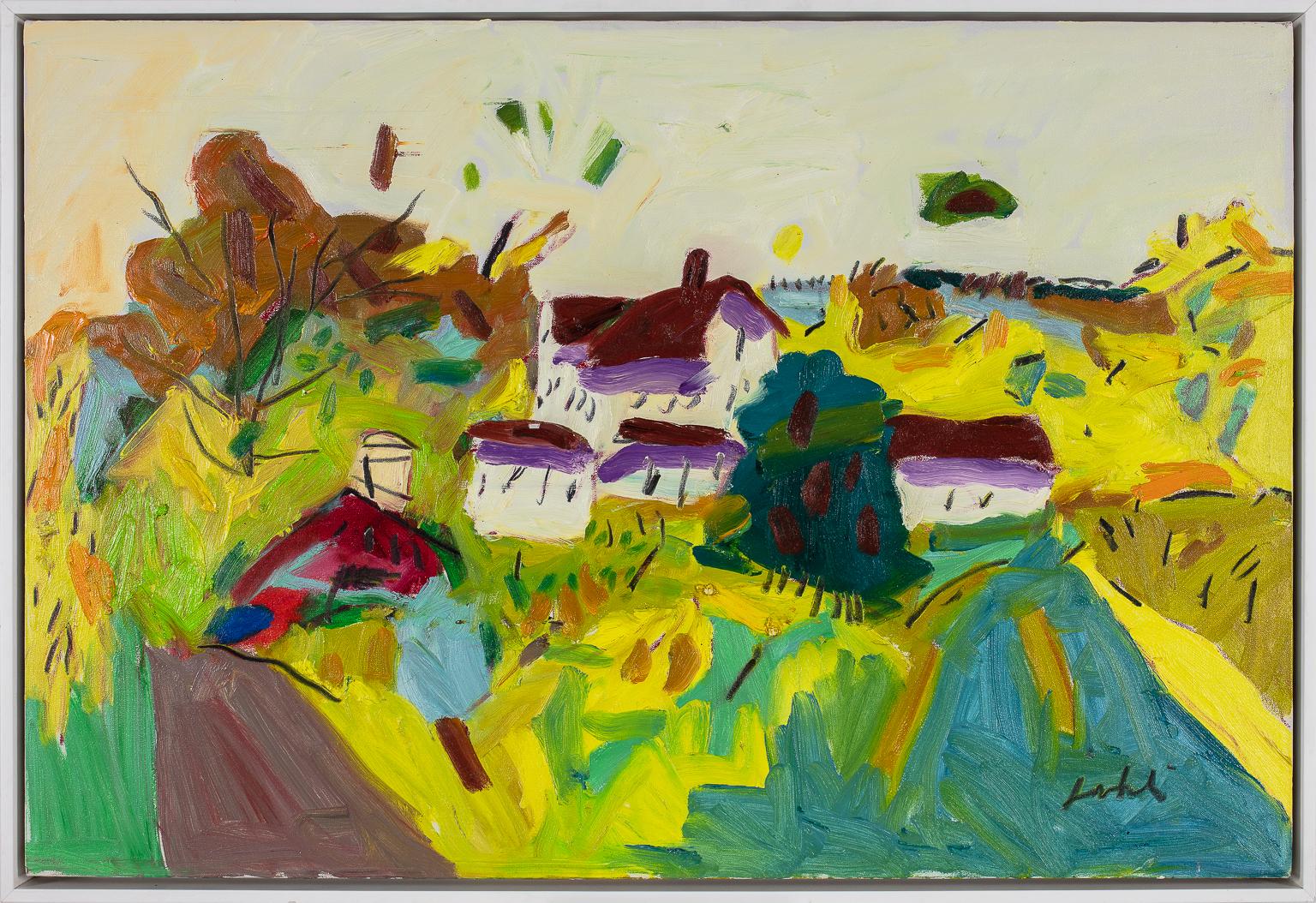Items Similar to Around the Camp Fire, 19th Century Oil Landscape Painting, Dated 1840
Want more images or videos?
Request additional images or videos from the seller
1 of 5
Around the Camp Fire, 19th Century Oil Landscape Painting, Dated 18401840
1840
About the Item
Oil on canvas, signed bottom right and dated '1840'
Image size: 22 x 30 inches (56 x 76.25 cm)
Albert Bierstadt
Recognized as the foremost painter of the American frontier during the nineteenth-century, Albert Bierstadt was born in Solingen, Germany, in 1830. At the age of two, he and his family emigrated to the United States, settling in New Bedford, Massachusetts. Nothing is known of his early art training; however, he might possibly have been influenced by local landscape painters. By the time he was twenty, he was supporting himself by teaching "monochromatic" painting and his work was beginning to attract the attention of New Bedford collectors.
In 1853, Bierstadt traveled to Düsseldorf in order to broaden his art education. It was there that he was associated with such American artists as Worthington Whittredge and Carl Wimar, all of whom frequently gathered in the studio of the German-American history painter, Emanuel Leutze. During this period, he was introduced to the work of Carl Friedrich Lessing and Andreas Aachenbach, contemporary German painters widely admired for their heroic, highly finished landscape compositions. Bierstadt quickly absorbed these stylistic conventions, eventually becoming the leading American representative of the Düsseldorf style.
While abroad, Bierstadt travelled along the Rhine, in the Alps and in Italy, often in the company of Whittredge, Sanford Gifford and William Stanley Haseltine. He returned to New Bedford in the autumn of 1857. In the following year, he made the first of his many contributions to the annual exhibitions of the National Academy of Design. In April of 1859, he joined the expedition along the Overland Trail, led by Colonel Frederick W. Lander, a trip that would soon give rise to the most productive and important phase of his career. Armed with sketches and stereographs, he returned to New York City in the autumn of 1859, establishing his studio in the Tenth Street Building. There he produced the first of the panoramic western landscapes that established his reputation on an international level and, during the mid-1860s, made him a rival of Frederick Church for the position of America's preeminent painter.
Indeed, because much of the continent remained still relatively unexplored at that time, Bierstadt's monumental renderings of stately mountains and cascading waterfalls created romantic visions of wanderlust in the minds of Easterners. His first public exhibition of these works in 1860 was a resounding success. Many critics deemed the viewing of his depictions as an almost "religious" experience, associating his mountain spires with majestic cathedrals, his luminous skies with the awesome power of God. As pointed out by Barbara Novak, such works represent the attitude of the "transcendental mind," one in which "all matter was an extension of God."
Bierstadt was elected a full Academician of the National Academy of Design in 1860. In the same year, he made several painting trips to the White Mountains as well as to the southern United States. He made a second trip to the West in 1863 which was followed by another visit to Europe in 1867. In 1871, he moved to California where he played an active role in the art life of San Francisco. In 1873, he returned to New York.
During the 1870s, Bierstadt executed a mural for the U.S. Capitol (1875) and in conjunction with the declining health of his wife, made the first of many trips to the Bahamas. He made a third trip to Europe in 1883. During 1889, he painted in both Alaska and British Columbia. He continued to produce landscapes throughout the 1890s. He also became involved in the promotion of various inventions, including his own designs for the improvement of railway cars.
Albert Bierstadt died in New York City in 1902. Although his reputation during the 1890s suffered slightly from the attraction for French art, his impact upon the American landscape tradition of the nineteenth century remains strong. His large-scale, panoramic landscapes, with their dramatic, almost sublime, light effects, coupled with the meticulous rendering of details, reflect the influences of both the contemporary landscape school of Düsseldorf as well as the native Hudson River School aesthetic. His works can be found in major public and private collections throughout North America and Europe, including the Metropolitan Museum of Art, the Wadsworth Atheneum, and the National Gallery of Canada.
- Creation Year:1840
- Dimensions:Height: 22 in (55.88 cm)Width: 32 in (81.28 cm)
- Medium:
- Circle Of:Albert Bierdstadt (1830 - 1902, German)
- Period:
- Framing:Framing Options Available
- Condition:
- Gallery Location:London, GB
- Reference Number:1stDibs: LU52413497602
About the Seller
5.0
Vetted Seller
These experienced sellers undergo a comprehensive evaluation by our team of in-house experts.
Established in 2007
1stDibs seller since 2014
63 sales on 1stDibs
Typical response time: 4 hours
- ShippingRetrieving quote...Ships From: London, United Kingdom
- Return PolicyA return for this item may be initiated within 14 days of delivery.
More From This SellerView All
- Back Gardens Original Oil Painting 20th Century Urban Landscape British ArtBy Alice Headley NeaveLocated in London, GBAlice Headley Neave 1903 - 1977 Back Gardens Oil on canvas, signed lower left Image size: 19 x 15 inches Contemporary style frame The daughter of Dr Arthur Henry Headley Huckle, Alice was...Category
20th Century Landscape Paintings
MaterialsCanvas, Oil
- Morning Drive in Hyde Park, 20th Century English Oil PaintingBy Doris ZinkeisenLocated in London, GBOil on canvas, signed lower right Image size: 28 3/4 x 28 3/4 inches (73 x 73 cm) Contemporary frame Doris Zinkeisen was a British painter, stage-set and costume designer, writer a...Category
Mid-20th Century English School Landscape Paintings
MaterialsCanvas, Oil
- The Artist at Work, 19th Century German Oil Landscape PaintingLocated in London, GBOil on canvas on board, signed lower left Image size: 12 1/4 x 19 inches (31 x 48.5 cm) Hand made gilt frame Johann Christian Kröner was the son of the decorative painter Johann Kröner (1788–1848) and his wife Clara Regina, née Meyer (1792–1862). Kröner attended high school in his hometown until 1852 and then worked for his brother, who had taken over the paternal painting business , as an apprentice. He also sketched outdoors to capture nature. It was only from 1861 that he could continue to devote himself to art. He first went to Munich and the artist colony in Brannenburg , where he painted landscapes and got to know local painters, including Carl Irmer , Wilhelm Busch , Julius Rollmann and Louis Hugo Becker . In 1863 he went to Düsseldorf, where he met the landscape painter Louis Hugo Becker, moving in the milieu of the Düsseldorf School. With his artist friends and paint box in hand, they worked from self-study and frequent trips to Upper Bavaria , Thuringia and particularly Westphalia. Among his circle of friends in Düsseldorf were Gustav Süs, Karl Bertling, Eduard Geselschap, Abert Baur, Eugen Dücker...Category
Late 19th Century Landscape Paintings
MaterialsCanvas, Oil
- The White Cross Inn, Richmond, New English Art Club Oil PaintingBy William Henry InnesLocated in London, GBOil on canvas, signed Image size: 20 x 24 inches Framed New English Art Club label to the back and his address for Herne Hill, LondonCategory
20th Century English School Landscape Paintings
MaterialsCanvas, Oil
- Island of Gibraltar, Oil 19th Century LandscapeLocated in London, GBOil on canvas Image size: 8 3/4 x 12 1/2 inches (22 1/4 x 31 3/4 cm) Gilt frame This is a painting from the 19th Century depicts Gibraltar Island in Ohio, America, located within la...Category
19th Century Victorian Landscape Paintings
MaterialsCanvas, Oil
- Notting Hill Gate Station from the Road, 20th Century Oil PaintingBy Edward McKnight KaufferLocated in London, GBOil on canvas board, signed lower left 'McKnight' Image size: 19 ½ x 14 ½ inches (49.5 x 37 cm) Contemporary frame Looking from the bridge we peer down the Notting Hill Gate Train S...Category
Early 20th Century Modern Landscape Paintings
MaterialsOil, Canvas
You May Also Like
- Bernhard ButerLocated in Saint Augustine, FLArtist: Bernhard Buter (1883-1959) German Title: Rhinish Landscape Medium: Oil on Canvas Dimensions: Framed 19” x 21” , Unframed 11 x 13” Bernhard Buter paints agrarian landscapes i...Category
Early 20th Century Realist Landscape Paintings
MaterialsCanvas, Oil
- "Les Falaise Normande" (The Cliffs Of Normand)By René GenisLocated in Berlin, MDRene Genis (French 1922-2004) “Les Falaise Normande” / The Cliffs of Normand. A sea scape with high cliffs, the beach, and two fishermen. The cliffs are in browns, tans and olives a...Category
1990s French School Landscape Paintings
MaterialsCanvas, Oil
- "Monument Valley"By René GenisLocated in Berlin, MDRene Genis (French 1922-2004) Monument Valley. 1967. Beautiful oranges, browns, greens against a turquoise blue sky. Oil on canvas, laid on mat. Si...Category
Mid-20th Century Landscape Paintings
MaterialsOil, Canvas
- Early oil depicting the Great Fire of LondonLocated in London, GBThe Great Fire of London in September 1666 was one of the greatest disasters in the city’s history. The City, with its wooden houses crowded together in narrow streets, was a natural fire risk, and predictions that London would burn down became a shocking reality. The fire began in a bakery in Pudding Lane, an area near the Thames teeming with warehouses and shops full of flammable materials, such as timber, oil, coal, pitch and turpentine. Inevitably the fire spread rapidly from this area into the City. Our painting depicts the impact of the fire on those who were caught in it and creates a very dramatic impression of what the fire was like. Closer inspection reveals a scene of chaos and panic with people running out of the gates. It shows Cripplegate in the north of the City, with St Giles without Cripplegate to its left, in flames (on the site of the present day Barbican). The painting probably represents the fire on the night of Tuesday 4 September, when four-fifths of the City was burning at once, including St Paul's Cathedral. Old St Paul’s can be seen to the right of the canvas, the medieval church with its thick stone walls, was considered a place of safety, but the building was covered in wooden scaffolding as it was in the midst of being restored by the then little known architect, Christopher Wren and caught fire. Our painting seems to depict a specific moment on the Tuesday night when the lead on St Paul’s caught fire and, as the diarist John Evelyn described: ‘the stones of Paul’s flew like grenades, the melting lead running down the streets in a stream and the very pavements glowing with the firey redness, so as no horse, nor man, was able to tread on them.’ Although the loss of life was minimal, some accounts record only sixteen perished, the magnitude of the property loss was shocking – some four hundred and thirty acres, about eighty per cent of the City proper was destroyed, including over thirteen thousand houses, eighty-nine churches, and fifty-two Guild Halls. Thousands were homeless and financially ruined. The Great Fire, and the subsequent fire of 1676, which destroyed over six hundred houses south of the Thames, changed the appearance of London forever. The one constructive outcome of the Great Fire was that the plague, which had devastated the population of London since 1665, diminished greatly, due to the mass death of the plague-carrying rats in the blaze. The fire was widely reported in eyewitness accounts, newspapers, letters and diaries. Samuel Pepys recorded climbing the steeple of Barking Church from which he viewed the destroyed City: ‘the saddest sight of desolation that I ever saw.’ There was an official enquiry into the causes of the fire, petitions to the King and Lord Mayor to rebuild, new legislation and building Acts. Naturally, the fire became a dramatic and extremely popular subject for painters and engravers. A group of works relatively closely related to the present picture have been traditionally ascribed to Jan Griffier...Category
17th Century Old Masters Landscape Paintings
MaterialsOil, Canvas
- Autumn Landscape with PurpleBy Zygmund JankowskiLocated in Gloucester, MAZygmund Jankowski (1925–2009) painted traditional subjects with exuberant irreverence for traditional rules of color, composition, and perspective. He disparaged imitation and deligh...Category
1980s Contemporary Landscape Paintings
MaterialsCanvas, Oil
- Flat Ledge Quarry with Golden TreesLocated in Gloucester, MAFlat Ledge Quarry is one of the many granite quarries in Rockport MA, which actively produced granite for cobblestones until the early 20th century, when asphault became the preferre...Category
2010s Contemporary Landscape Paintings
MaterialsCanvas, Oil
Recently Viewed
View AllMore Ways To Browse
Alaska Native Artists
New Mexico Colorado Painting
Jo Paul
Antique Oil Painting Snow
Saint Germain Paris
Large Landscape Oil Paintings Of Texas
Steamship Oil On Board
Maine Beach Paintings
L Stanley
George H Hughes
Michael Kane
Early American Families
Walking On Beach
Dusk London
19th Century Irish Painting
Battle Brown Hudson





